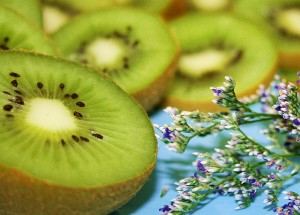Checklist for Going Vegan
This week was supposed to be our first week of “The Vegan Experiment.” Jay came home one day last month and said he wanted to try going vegan for a month. I need to fill you in on Jay’s eating habits — he’s the pickiest eater ever! I mean the pickiest! So this presented quite a challenge.
I told him that a month was a long commitment — so how about if we tried doing it for a week? He agreed. I had seen an Oprah episode where her entire staff went on a vegan diet for a week and the results were pretty stunning. People had more energy, were more regular and felt better overall. Those are pretty great side effects.
Despite my support — Jay chickened out. (haha — I wasn’t even trying to make a carnivore joke!) So I think we’ll try vegan meals once in a while at least– just to see what it’s all about. But I realized that I don’t know the first thing about going vegan — or what I need to get rid of or stock up on in our kitchen. I, of course — reached out to a friend for a list!
A Beginner’s List for Going Vegan
by George Nickle
I have been Vegan for 8 years and was Vegetarian for 10 years before then. Let me begin by saying that while I live in LA now, I am a country boy. I grew up in the middle of orchards and dairy farms. I was raised on unpasteurized milk and I have seen animals butchered in the morning, then on my plate for dinner. This is how the majority of humans experienced the food chain during our species’ existence. So if you are thinking about giving Veganism a try and are a little scared, know that I understand where you are at. For a good bit of my life — a meal wasn’t a meal unless it was mostly meat.
I love animals but stopped eating them mainly for health reasons. I got fat as a teen and was already in diet mode when I read about the truly disgusting conditions in factory farms (I was living far away from my bucolic roots and family farms by then.) I gave up meat right then and honestly never missed it. As a Vegan I maintain a healthy weight and feel better than ever. If you want to do the same here is a list to get you going:
1. Thou shalt not eat: meat (yes that includes fish and I can’t understand why people even ask that, but they do), dairy, eggs or honey. Nothing that comes from an animal, even if it doesn’t kill them to take it.
2. Make a list of what you normally eat in a day. Break it down by meals and cross off anything that falls into the category above. You will have some holes in your diet but we’ll fill them.
3. Find alternatives! Most people think Vegans eat nothing but leaves, grain and beans and that to become one you will never have favorites like ice cream or chocolate again. Wrong. Especially over the last few years — more and more products have hit the market that look, smell and taste like the foods you grew up with. They often are far more processed and contain more fat and calories than good old leaves and beans, but they are good comfort foods and really important during the transition from carnivore to Vegan. Some favorites:
- Almond Breeze Almond Milk (www.almondbreeze.com) in place of milk (note: there are many soy, rice, coconut, oat and even hemp alternatives to milk. This tastes best to me.)
- Earth Balance Organic Buttery Spread (www.earthbalancenatural.com) in place of butter.
- Gardein (www.gardein.com) in place of meat. These guys are fairly new, but boy are they good! They make crispy tenders (like chicken fingers,) scallopini, burgers and lots more. I’ve found them in major grocery chains from LA to small town North Carolina.
- Morning Star Farms (www.morningstarfarms.com) is much better known and even more widely available. Many of their products contain egg. If they do they will be labeled “Vegetarian” above the nutrition facts. Vegan items will be labeled “Vegan.”
- Purely Decadent & Soy Delicious (www.turtlemountain.com) in place of ice cream. They make amazing frozen desserts (and more) in a wide variety of familiar flavors.
- Diaya (www.daiyafoods.com) in place of cheese. This is something of a revolution when it comes to Vegan cheeses. There are others, but this stuff has the right melt, texture and taste. And I’ve started to see it in major grocery chains.
4. Replace your haunts. List where you normally eat out and grocery shop. Do some reconnaissance at your usual grocery stores to see which of the products I listed above they have. When you find them look around them, literally. Most of the meatless items are grouped together and you are sure to find more things you want to try. The big grocery chain in LA is Ralph’s and they have even begun listing many items in their own brand as Vegan. Maybe your local chain does too. There is always Whole Foods, Trader Joe’s (check out their great Vegan item’s list: www.traderjoes.com/lists/vegan.asp) and probably more than one local health food grocery that will probably have cool local items the bigger chains won’t.
Restaurants may be harder. You probably have favorites but they may no longer be able to accommodate your diet. I personally avoid eating at all but totally Vegan restaurants if I can. I just can’t stand the smell of meat any more and the thought of transfer in the kitchen makes me ill. What else did they cut with that knife that chopped up my salad greens? It is easy for me, I live in a big city filled with great Vegan restaurants. But they are popping up all over.
A favorite California chain of mine, Native Foods (www.nativefoods.com), is not only expanding all over Southern California, but Chicago too! NYC is loaded with great places like my favorite Vegan restaurant anywhere, Candle 79 (www.candle79.com — try the poletna fries!), and the amazing bakery Babycakes (www.babycakesnyc.com — now in CA too!). San Francisco has Herbivore (www.herbivorerestaurant.com) in several locations and if you want to lay out some bucks Millennium (www.millenniumrestaurant.com.) Veggie Grill (www.veggiegrill.com) is expanding and is delicious. For something local try Happy Cow (www.happycow.net) for international listings of restaurants and grocery stores. Also check out my favorite Vegan blog: www.quarrygirl.com.
5. Read labels! Now it gets tricky. You thought the above was challenging, this will not only prove challenging but eye-opening. You have no idea what you’ve been eating all of your life, but as a Vegan you have to know to avoid hidden animal ingredients. Nutritional labels are your friends. The quickest way to tell that something is not Vegan is if it has cholesterol. If it does it has something from an animal and we don’t eat it.
Ingredient lists are our best friends. If something is listed and you don’t know what it is — then you don’t know where it came from and you don’t eat it. You need to head to the internet and find some reliable Vegan Ingredient lists. Study them, print them and hang them in your kitchen. When you shop, take them with you. Also check out www.vegan.org/campaigns/certification/index.html for certified Vegan items. Their symbol is easily recognizable. But as you study, and realize what things you never thought twice about putting in your mouth actually are, I think your commitment to Veganism will be strengthened.
Did you know what gelatine actually is? Bones, skin, hooves. Yuk! And it isn’t just in colorful wiggly desserts, it is in tons of stuff! Like marshmallows and Altoids (as a Vegan you have to consider things like mints and gum too). How about Carmine? Sounds nice enough. You’ll find it all sorts of foods. It’s a red food coloring and it is made from ground up beetle shells. As in bugs, ground up and added to your food to make it pretty. Starting to see why reading, and understanding, labels is worth the effort?
6. Be prepared to become a detective. Some food additives can come from Vegan and non-Vegan sources. And that is a pain in the butt. If you aren’t sure, best to just move on. But if it is something you really want to eat, say a favorite brand, you will have to become a detective. Go to the company website and e-mail them. Most are pretty good about getting back to you. I had this problem just recently when my favorite food in the world (not kidding,) — Snyder’s of Hanover Sourdough Hard Pretzels changed their recipe on me. Since I was eating them as a little boy in Pennsylvania they had five ingredients, the first being whole wheat unbleached flour. Suddenly they changed it to enriched wheat flour, which is seven ingredients on its own. Enriched flour is always a problem because most of those vitamins can come from animal sources (like niacin, thiamin, riboflavin.) I e-mailed the company and heard back from a nice lady named Mary Ruth in two days assuring me that my beloved pretzels are still Vegan.
7. Some bummers. I have some more bad news about favorite foods that you would never think of as having any animal anything in them but just might: sugar and alcohol. But the good thing is neither is great for you and being Vegan will limit your consumption of both. White sugar is processed, some of it being filtered through charcoal made from bone char. While that bone char might not be in the final product, it just doesn’t seem to be very Vegan to many. Me included.
On to the drinks! Lots wines, liqueurs and beers use very non-Vegan fining agents like gelatine, eggs, milk, even blood. Worry not! Again, Trader Joe’s to the rescue with a $5 wine from Spain called Albero. At least two of this label’s wines are Vegan, including a sparkling, and for $5 they aren’t bad.
8. Nutrition. You get enough protein and calcium as a Vegan. At least one with a well-balanced diet. If you spent all of your time downing cupcakes from Babycakes with that $5 Vegan wine you might technically be Vegan, but probably not very healthy. My almond milk has more calcium than cow’s milk. Beans and nuts have lots of protein. A bag of Gardein crispy tenders has 40 grams of it vs. 63 for the same amount of beef. I still take a daily multivitamin as there are some vitamins that aren’t as easy to come by in a Vegan diet (like B12 & D.)
9. Money. Get ready to spend more on food. Cheap food just tends to be bad for you. Why are so many poor people fat? Is it because they have more to eat? Spend more on food? No. It is because the food they can afford is loaded with preservatives, chemicals and just cheaper ingredients. Being poor was a major reason I got so fat as a teenager. But shop around for deals. Farmer’s markets often have great prices on really good fresh fruits and vegetables. Most of the brands listed above will offer coupons from time to time. Bottom line, your health is worth the time and money it takes to be a Vegan. And I’ll bet you’ll save on doctor’s bills. I haven’t needed to go to one in forever and then it an exercise related injury.
10. Health Benefits. From maintaining a healthy weight, to lowering risks of cancer, heart disease and diabetes, if that won’t convince you nothing will. And once you are committed we can talk about ditching that leather wallet, belt, watch band, shoes, silk shirts and ties and then we’ll get into cosmetics, cologne, perfume and more. Won’t that be fun!
 George Nickle has worked as talent manager and ran a DVD label focusing on independent and documentary films. Now he is concentrating on his writing: shopping his first novel, a non-fiction book and a pilot. George loves history, politics and amazingly bad movies (as well as some really good ones.) His work has appeared in such places as American Atheist Magazine and Weird Load Nation.
George Nickle has worked as talent manager and ran a DVD label focusing on independent and documentary films. Now he is concentrating on his writing: shopping his first novel, a non-fiction book and a pilot. George loves history, politics and amazingly bad movies (as well as some really good ones.) His work has appeared in such places as American Atheist Magazine and Weird Load Nation.



Leave a Reply
Want to join the discussion?Feel free to contribute!